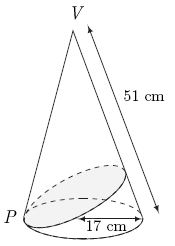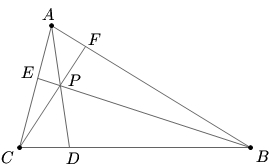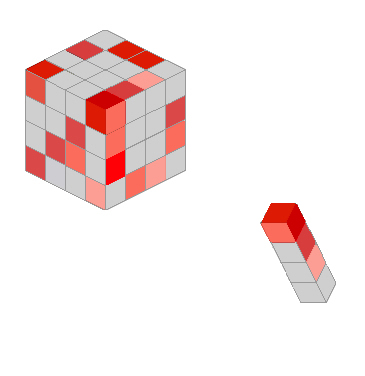Difference between revisions of "Mock AIME 2 2006-2007 Problems"
m (→Problem 1) |
(→Problem 7) |
||
| (3 intermediate revisions by 2 users not shown) | |||
| Line 1: | Line 1: | ||
== Problem 1 == | == Problem 1 == | ||
| − | A positive integer is called a dragon if it can be | + | A positive integer is called a ''dragon'' if it can be written as the sum of four positive integers <math>a,b,c,</math> and <math>d</math> such that <math>a+4=b-4=4c=d/4.</math> Find the smallest dragon. |
| − | [[Mock_AIME_2_2006-2007/Problem_1|Solution]] | + | [[Mock_AIME_2_2006-2007 Problems/Problem_1|Solution]] |
== Problem 2 == | == Problem 2 == | ||
| − | The set <math> | + | The set <math>S</math> consists of all integers from <math>1</math> to <math>2007,</math> inclusive. For how many elements <math>n</math> in <math>S</math> is <math>f(n) = \frac{2n^3+n^2-n-2}{n^2-1}</math> an integer? |
| − | [[Mock_AIME_2_2006-2007/Problem_2|Solution]] | + | [[Mock_AIME_2_2006-2007 Problems/Problem_2|Solution]] |
== Problem 3 == | == Problem 3 == | ||
| − | Let <math> | + | Let <math>S</math> be the sum of all positive integers <math>n</math> such that <math>n^2+12n-2007</math> is a perfect square. Find the remainder when <math>S</math> is divided by <math>1000.</math> |
| − | [[Mock_AIME_2_2006-2007/Problem_3|Solution]] | + | [[Mock_AIME_2_2006-2007 Problems/Problem_3|Solution]] |
== Problem 4 == | == Problem 4 == | ||
| − | Let <math> | + | Let <math>n</math> be the smallest positive integer for which there exist positive real numbers <math>a</math> and <math>b</math> such that <math>(a+bi)^n=(a-bi)^n</math>. Compute <math>\frac{b^2}{a^2}</math>. |
| − | [[Mock_AIME_2_2006-2007/Problem_4|Solution]] | + | [[Mock_AIME_2_2006-2007 Problems/Problem_4|Solution]] |
== Problem 5 == | == Problem 5 == | ||
| − | Given that <math> | + | Given that <math> iz^2=1+\frac 2z + \frac{3}{z^2}+\frac{4}{z ^3}+\frac{5}{z^4}+\cdots</math> and <math>z=n\pm \sqrt{-i},</math> find <math> \lfloor 100n \rfloor.</math> |
| − | [[Mock_AIME_2_2006-2007/Problem_5|Solution]] | + | [[Mock_AIME_2_2006-2007 Problems/Problem_5|Solution]] |
== Problem 6 == | == Problem 6 == | ||
| − | If <math> | + | If <math>\tan 15^\circ \tan 25^\circ \tan 35^\circ =\tan \theta</math> and <math>0^\circ \le \theta \le 180^\circ, </math> find <math>\theta.</math> |
| − | [[Mock_AIME_2_2006-2007/Problem_6|Solution]] | + | [[Mock_AIME_2_2006-2007 Problems/Problem_6|Solution]] |
== Problem 7 == | == Problem 7 == | ||
| − | A right circular cone of base radius <math> | + | A right circular cone of base radius <math>17</math>cm and slant height <math>51</math>cm is given. <math>P</math> is a point on the circumference of the base and the shortest path from <math>P</math> around the cone and back is drawn (see diagram). If the length of this path is <math>m\sqrt{n},</math> where <math>m</math> and <math>n</math> are relatively prime positive integers, find <math>m+n.</math> |
[[Image:Mock_AIME_2_2007_Problem8.jpg]] | [[Image:Mock_AIME_2_2007_Problem8.jpg]] | ||
| − | [[Mock_AIME_2_2006-2007/Problem_7|Solution]] | + | [[Mock_AIME_2_2006-2007 Problems/Problem_7|Solution]] |
== Problem 8 == | == Problem 8 == | ||
| − | The positive integers <math> | + | The positive integers <math>x_1, x_2, ... , x_7</math> satisfy <math>x_6 = 144</math> and <math>x_{n+3} = x_{n+2}(x_{n+1}+x_n)</math> for <math>n = 1, 2, 3, 4</math>. Find the last three digits of <math>x_7</math>. |
| − | [[Mock_AIME_2_2006-2007/Problem_8|Solution]] | + | [[Mock_AIME_2_2006-2007 Problems/Problem_8|Solution]] |
== Problem 9 == | == Problem 9 == | ||
| − | In right triangle <math> | + | In right triangle <math>ABC,</math> <math>\angle C=90^\circ.</math> Cevians <math>AX</math> and <math>BY</math> intersect at <math>P</math> and are drawn to <math>BC</math> and <math>AC</math> respectively such that <math>\frac{BX}{CX}=\frac23</math> and <math>\frac{AY}{CY}=\sqrt 3.</math> If <math>\tan \angle APB= \frac{a+b\sqrt{c}}{d},</math> where <math>a,b,</math> and <math>d</math> are relatively prime and <math>c</math> has no perfect square divisors excluding <math>1,</math> find <math>a+b+c+d.</math> |
| − | [[Mock_AIME_2_2006-2007/Problem_9|Solution]] | + | [[Mock_AIME_2_2006-2007 Problems/Problem_9|Solution]] |
== Problem 10 == | == Problem 10 == | ||
| − | Find the number of solutions, in degrees, to the equation <math> | + | Find the number of solutions, in degrees, to the equation <math>\sin^{10}x + \cos^{10}x = \frac{29}{16}\cos^4 2x,</math> where <math>0^\circ \le x^\circ \le 2007^\circ.</math> |
| − | [[Mock_AIME_2_2006-2007/Problem_10|Solution]] | + | [[Mock_AIME_2_2006-2007 Problems/Problem_10|Solution]] |
== Problem 11 == | == Problem 11 == | ||
Find the sum of the squares of the roots, real or complex, of the system of simultaneous equations | Find the sum of the squares of the roots, real or complex, of the system of simultaneous equations | ||
| − | <math> | + | <math>x+y+z=3,~x^2+y^2+z^2=3,~x^3+y^3+z^3 =3.</math> |
| − | [[Mock_AIME_2_2006-2007/Problem_11|Solution]] | + | [[Mock_AIME_2_2006-2007 Problems/Problem_11|Solution]] |
== Problem 12 == | == Problem 12 == | ||
| − | In quadrilateral <math> | + | In quadrilateral <math>ABCD,</math> <math>m \angle DAC= m\angle DBC </math> and <math>\frac{[ADB]}{[ABC]}=\frac12.</math> If <math>AD=4,</math> <math>BC=6</math>, <math>BO=1,</math> and the area of <math>ABCD</math> is <math>\frac{a\sqrt{b}}{c},</math> where <math>a,b,c</math> are relatively prime positive integers, find <math>a+b+c.</math> |
| − | Note*: <math> | + | Note*: <math>[ABC]</math> and <math>[ADB]</math> refer to the areas of triangles <math>ABC</math> and <math>ADB.</math> |
| − | [[Mock_AIME_2_2006-2007/Problem_12|Solution]] | + | [[Mock_AIME_2_2006-2007 Problems/Problem_12|Solution]] |
== Problem 13 == | == Problem 13 == | ||
| − | In his spare time, Richard Rusczyk shuffles a standard deck of 52 playing cards. He then turns the cards up one by one from the top of the deck until the third ace appears. If the expected (average) number of cards Richard will turn up is <math> | + | In his spare time, Richard Rusczyk shuffles a standard deck of 52 playing cards. He then turns the cards up one by one from the top of the deck until the third ace appears. If the expected (average) number of cards Richard will turn up is <math>m/n,</math> where <math>m</math> and <math>n</math> are relatively prime positive integers, find <math>m+n.</math> |
| − | [[Mock_AIME_2_2006-2007/Problem_13|Solution]] | + | [[Mock_AIME_2_2006-2007 Problems/Problem_13|Solution]] |
== Problem 14 == | == Problem 14 == | ||
| − | In triangle ABC, <math> | + | In triangle ABC, <math>AB = 308</math> and <math>AC=35.</math> Given that <math>AD</math>, <math>BE,</math> and <math>CF,</math> intersect at <math>P</math> and are an angle bisector, median, and altitude of the triangle, respectively, compute the length of <math>BC.</math> |
[[Image:Mock AIME 2 2007 Problem14.jpg]] | [[Image:Mock AIME 2 2007 Problem14.jpg]] | ||
| − | [[Mock_AIME_2_2006-2007/Problem_14|Solution]] | + | [[Mock_AIME_2_2006-2007 Problems/Problem_14|Solution]] |
== Problem 15 == | == Problem 15 == | ||
| − | A <math> | + | A <math>4\times4\times4</math> cube is composed of <math>64</math> unit cubes. The faces of <math>16</math> unit cubes are colored red. An arrangement of the cubes is <math>\mathfrak{Intriguing}</math> if there is exactly <math>1</math> red unit cube in every <math>1\times1\times4</math> rectangular box composed of <math>4</math> unit cubes. Determine the number of <math>\mathfrak{Intriguing}</math> colorings. |
| − | [[Mock_AIME_2_2006-2007/Problem_15|Solution]] | + | [[Mock_AIME_2_2006-2007 Problems/Problem_15|Solution]] |
[[Image:CubeArt.jpg]] | [[Image:CubeArt.jpg]] | ||
Latest revision as of 22:49, 25 February 2017
Contents
Problem 1
A positive integer is called a dragon if it can be written as the sum of four positive integers ![]() and
and ![]() such that
such that ![]() Find the smallest dragon.
Find the smallest dragon.
Problem 2
The set ![]() consists of all integers from
consists of all integers from ![]() to
to ![]() inclusive. For how many elements
inclusive. For how many elements ![]() in
in ![]() is
is ![]() an integer?
an integer?
Problem 3
Let ![]() be the sum of all positive integers
be the sum of all positive integers ![]() such that
such that ![]() is a perfect square. Find the remainder when
is a perfect square. Find the remainder when ![]() is divided by
is divided by ![]()
Problem 4
Let ![]() be the smallest positive integer for which there exist positive real numbers
be the smallest positive integer for which there exist positive real numbers ![]() and
and ![]() such that
such that ![]() . Compute
. Compute ![]() .
.
Problem 5
Given that ![]() and
and ![]() find
find ![]()
Problem 6
If ![]() and
and ![]() find
find ![]()
Problem 7
A right circular cone of base radius ![]() cm and slant height
cm and slant height ![]() cm is given.
cm is given. ![]() is a point on the circumference of the base and the shortest path from
is a point on the circumference of the base and the shortest path from ![]() around the cone and back is drawn (see diagram). If the length of this path is
around the cone and back is drawn (see diagram). If the length of this path is ![]() where
where ![]() and
and ![]() are relatively prime positive integers, find
are relatively prime positive integers, find ![]()
Problem 8
The positive integers ![]() satisfy
satisfy ![]() and
and ![]() for
for ![]() . Find the last three digits of
. Find the last three digits of ![]() .
.
Problem 9
In right triangle ![]()
![]() Cevians
Cevians ![]() and
and ![]() intersect at
intersect at ![]() and are drawn to
and are drawn to ![]() and
and ![]() respectively such that
respectively such that ![]() and
and ![]() If
If ![]() where
where ![]() and
and ![]() are relatively prime and
are relatively prime and ![]() has no perfect square divisors excluding
has no perfect square divisors excluding ![]() find
find ![]()
Problem 10
Find the number of solutions, in degrees, to the equation ![]() where
where ![]()
Problem 11
Find the sum of the squares of the roots, real or complex, of the system of simultaneous equations
![]()
Problem 12
In quadrilateral ![]()
![]() and
and ![]() If
If ![]()
![]() ,
, ![]() and the area of
and the area of ![]() is
is ![]() where
where ![]() are relatively prime positive integers, find
are relatively prime positive integers, find ![]()
Note*: ![]() and
and ![]() refer to the areas of triangles
refer to the areas of triangles ![]() and
and ![]()
Problem 13
In his spare time, Richard Rusczyk shuffles a standard deck of 52 playing cards. He then turns the cards up one by one from the top of the deck until the third ace appears. If the expected (average) number of cards Richard will turn up is ![]() where
where ![]() and
and ![]() are relatively prime positive integers, find
are relatively prime positive integers, find ![]()
Problem 14
In triangle ABC, ![]() and
and ![]() Given that
Given that ![]() ,
, ![]() and
and ![]() intersect at
intersect at ![]() and are an angle bisector, median, and altitude of the triangle, respectively, compute the length of
and are an angle bisector, median, and altitude of the triangle, respectively, compute the length of ![]()
Problem 15
A ![]() cube is composed of
cube is composed of ![]() unit cubes. The faces of
unit cubes. The faces of ![]() unit cubes are colored red. An arrangement of the cubes is
unit cubes are colored red. An arrangement of the cubes is ![]() if there is exactly
if there is exactly ![]() red unit cube in every
red unit cube in every ![]() rectangular box composed of
rectangular box composed of ![]() unit cubes. Determine the number of
unit cubes. Determine the number of ![]() colorings.
colorings.












